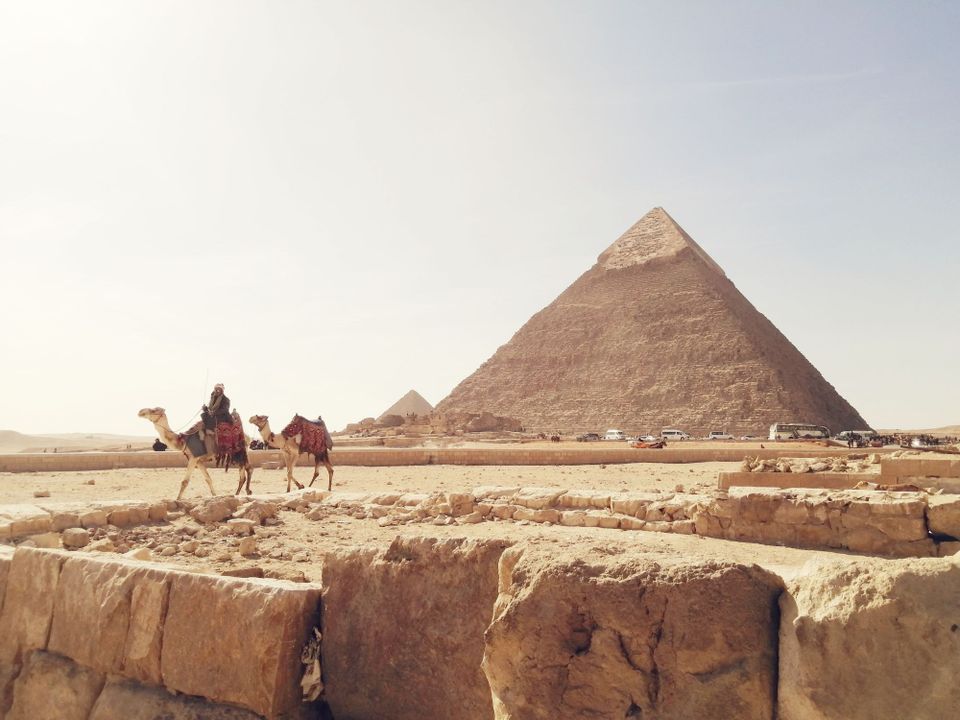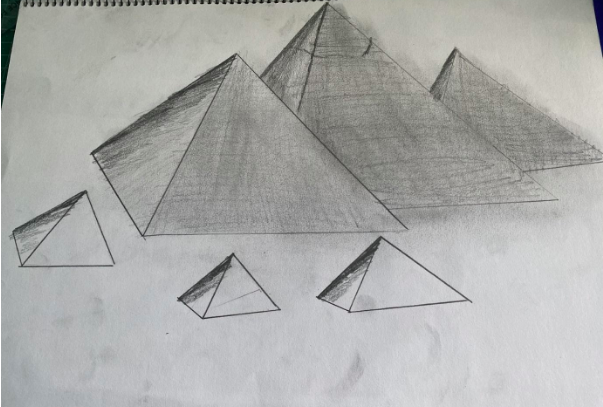The Pyramids of Giza

The Pyramids of Giza or the Giza Necropolis was built in the time of three rulers of Egypt. Pharaohs Khufu, Khafre and Menkaure built the three pyramids and the sphinx. It is located on the outskirts of the Western Desert and roughly 13 kilometres away from Cairo, the capital of Egypt.
It was a hot and humid day in Giza, Egypt. Pharaoh Khufu was thinking about how he must be buried. His days are short but there were lots and lots of his generation to come, he truly wanted to be remembered as a true king with a golden heart and an ego that was brighter than the moon. He thought of the average tomb and decided, why not go for something peculiar to grab everyone’s attention. He thought of the many odd shapes to be buried in, a sphere, a cylinder, an icosahedron or a torus. But alas, one type of shape was in reach of his time and its modern technology, it was simple but yet grand and peculiar at the same time, it was the pyramid! He wanted every one of his generations to be buried like this so as to follow his great legacy.
The Pyramids of Giza can also be known as the Giza Necropolis, it is one of the Seven Wonders of the World. It was built in the times of Ancient Egypt it is a historical landmark in Giza, Egypt of intricate beauty and architectural feats. It is on the outskirts of the Western Desert, almost about 9 kilometres west of the Nile River in the city of Giza, and about 13 kilometres away from the city of Cairo, the capital of Egypt.

Khufu's pyramid complex has a valley temple, now it is buried beneath the village of Nazlet el-Samman; many diabase paving and nummulitic limestone walls have been found at the site but has not yet been excavated. It has been found that the valley temple was connected to a causeway that had been largely destroyed when the village was built. Of this temple, the Basalt pavement was only found. The causeway led to the Mortuary Temple of Khufu. Pharaoh Khufu’s pyramid, completed in 2560 BC, has three smaller queen’s pyramids associated with it and 3 boat pits. Some of the ships were destroyed by the weathering and time but 2 ships remained intact. Khufu’s one was restored and is now on display at the Giza Solar Boat Museum. The king’s pyramid still has a limited amount of stone casings at the base. These limestone casings were made in a land not far away.
Khafre's pyramid complex consists of a valley temple, a Sphinx statue, a causeway, a mortuary temple and the king’s pyramid. Several statues of Khafre were found in a well on the floor of the temple by Mariette in 1860. Others were found during successive excavations by Sieglin, Junker, Reisner, and Hassan. Khafre's complex contained five boat-pits and a subsidiary pyramid with a serdab. Khafre's pyramid, completed in 2570 BC, appears larger than the adjacent Khufu Pyramid by virtue of its more elevated location, and the steeper angle of inclination of its construction—it is, in fact, smaller in both height and volume. Khafre's pyramid retains a prominent display of casing stones at its apex.
In addition, Khafre built a Sphinx, later during queen Amenhotep II’s ruling period, she dedicated a temple to Hauron-Haremakhet and the structure was finished off by later rulers.
Menkaure's pyramid complex consists of a valley temple, a causeway, a mortuary temple, and the king's pyramid. The workers’ village is near Menkaure’s pyramid, it housed the skilled workers and other labourers that lived there to help build the Giza Complex, taking 3 month shifts at a time for 100,000 men.
In conclusion, I would like to highlight that the Pyramids of Giza are a wonderful piece of history and it is very inspiring for those who are in need of it. At that time people didn’t have any kind of technology. We must take note that this is one amazing creation of mankind.
References
https://en.wikipedia.org/wiki/Giza_pyramid_complex
https://www.nationalgeographic.com/history/article/giza-pyramids
https://www.britannica.com/topic/Pyramids-of-Giza
Author biography
Mohamed Fariz Azim is a participant in the Leaders of Tomorrow programme of theCircle by Ugail Foundation. He aspires to be a leader in his field and strives to achieve high standards. In his spare time, he loves to draw, read, write, and play video games.

Cite this article as:
Mohamed Fariz Azim, The Pyramids of Giza, theCircle Composition, Volume 1, (2021). https://thecirclecomposition.org/the-pyramids-of-giza/
